Business Process Analysis of Swinburne Logistics Group - INF30005
VerifiedAdded on 2023/04/25
|15
|2285
|151
Report
AI Summary
This report presents a business process analysis of the Swinburne Logistics Group, focusing on the "as-is" processes of receiving and delivering goods. The analysis identifies key issues within the current operations, such as manual processes, improper communication between the warehouse and headquarters, and data flow inefficiencies. The report includes BPMN diagrams to visually represent the processes and outlines steps for process redesign, including defining objectives, identifying customer needs, studying the current process, and formulating a redesign plan. The report emphasizes the importance of business process reengineering and its potential to improve efficiency, reduce costs, and enhance communication within the organization. It concludes by highlighting the importance of the business process model in capturing and portraying the internal processes of an organization accurately and correctly. The report also references several academic papers related to business process management and reengineering.
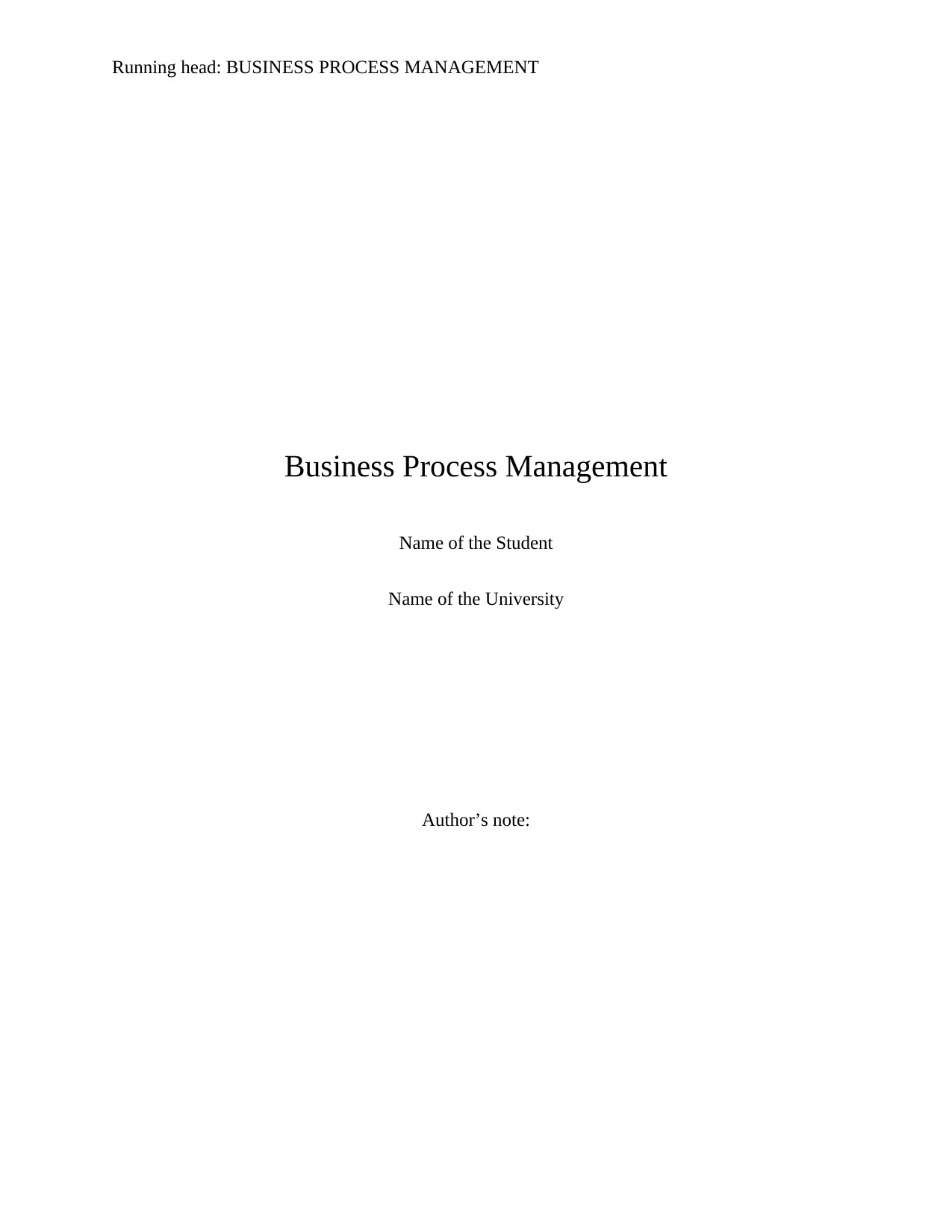
Running head: BUSINESS PROCESS MANAGEMENT
Business Process Management
Name of the Student
Name of the University
Author’s note:
Business Process Management
Name of the Student
Name of the University
Author’s note:
Paraphrase This Document
Need a fresh take? Get an instant paraphrase of this document with our AI Paraphraser
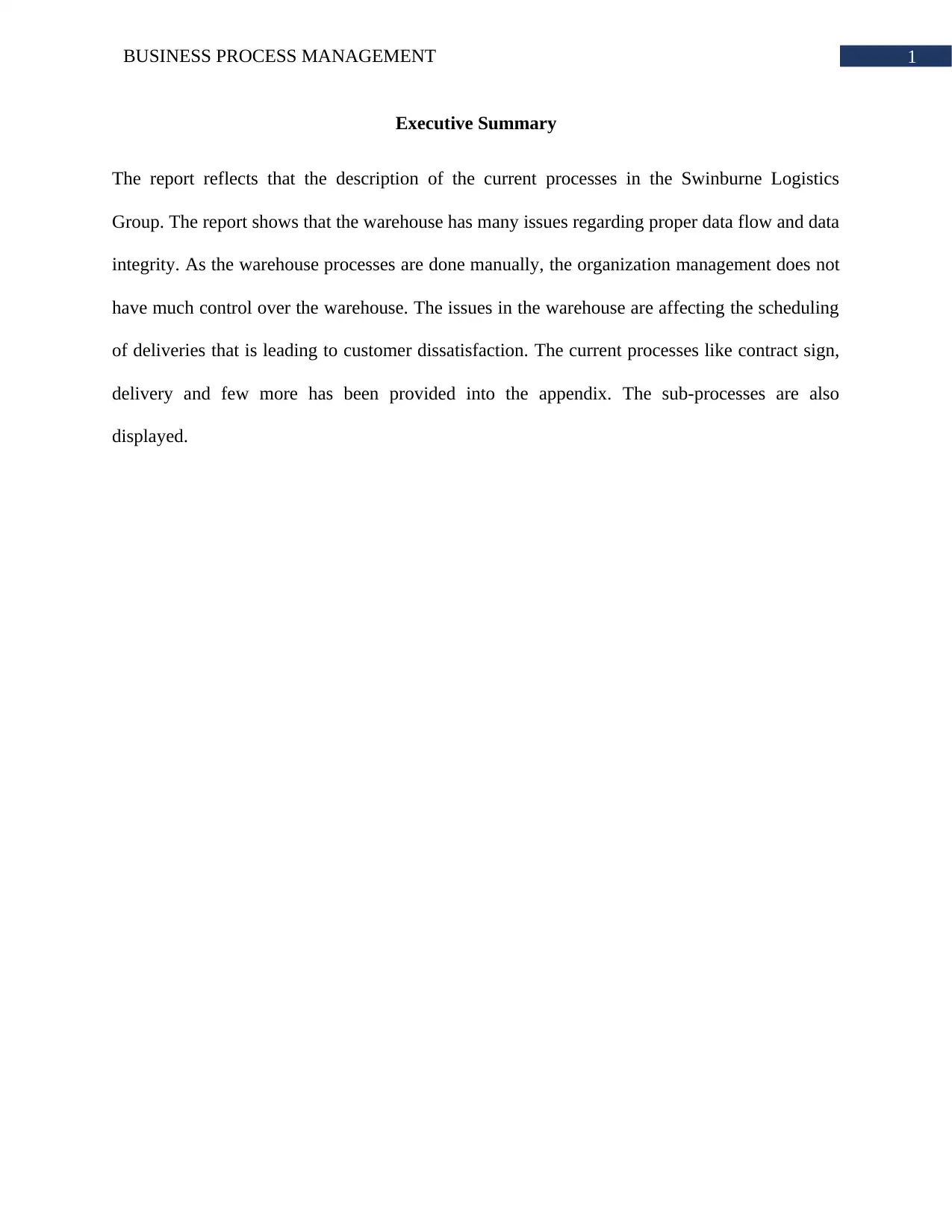
1BUSINESS PROCESS MANAGEMENT
Executive Summary
The report reflects that the description of the current processes in the Swinburne Logistics
Group. The report shows that the warehouse has many issues regarding proper data flow and data
integrity. As the warehouse processes are done manually, the organization management does not
have much control over the warehouse. The issues in the warehouse are affecting the scheduling
of deliveries that is leading to customer dissatisfaction. The current processes like contract sign,
delivery and few more has been provided into the appendix. The sub-processes are also
displayed.
Executive Summary
The report reflects that the description of the current processes in the Swinburne Logistics
Group. The report shows that the warehouse has many issues regarding proper data flow and data
integrity. As the warehouse processes are done manually, the organization management does not
have much control over the warehouse. The issues in the warehouse are affecting the scheduling
of deliveries that is leading to customer dissatisfaction. The current processes like contract sign,
delivery and few more has been provided into the appendix. The sub-processes are also
displayed.
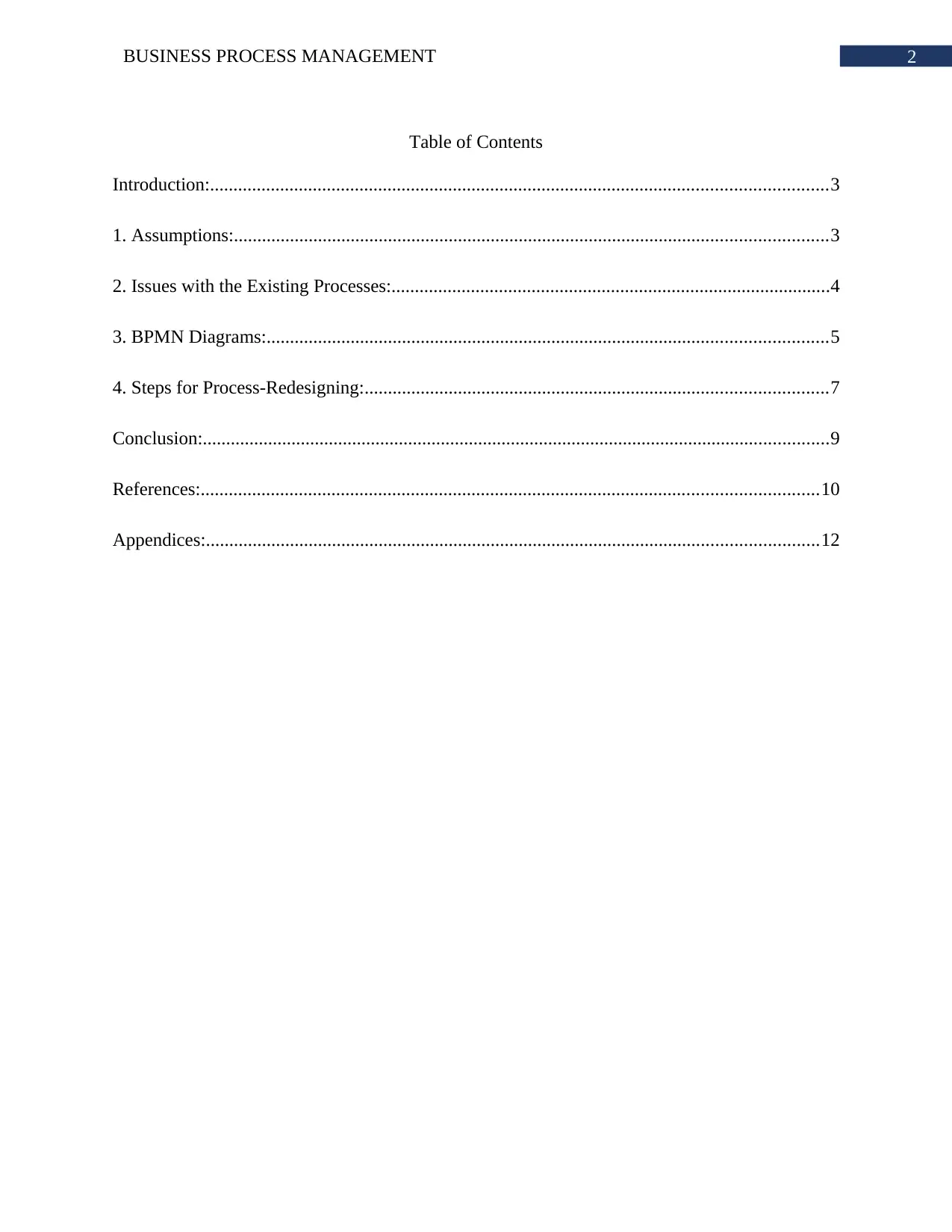
2BUSINESS PROCESS MANAGEMENT
Table of Contents
Introduction:....................................................................................................................................3
1. Assumptions:...............................................................................................................................3
2. Issues with the Existing Processes:..............................................................................................4
3. BPMN Diagrams:........................................................................................................................5
4. Steps for Process-Redesigning:...................................................................................................7
Conclusion:......................................................................................................................................9
References:....................................................................................................................................10
Appendices:...................................................................................................................................12
Table of Contents
Introduction:....................................................................................................................................3
1. Assumptions:...............................................................................................................................3
2. Issues with the Existing Processes:..............................................................................................4
3. BPMN Diagrams:........................................................................................................................5
4. Steps for Process-Redesigning:...................................................................................................7
Conclusion:......................................................................................................................................9
References:....................................................................................................................................10
Appendices:...................................................................................................................................12
⊘ This is a preview!⊘
Do you want full access?
Subscribe today to unlock all pages.

Trusted by 1+ million students worldwide
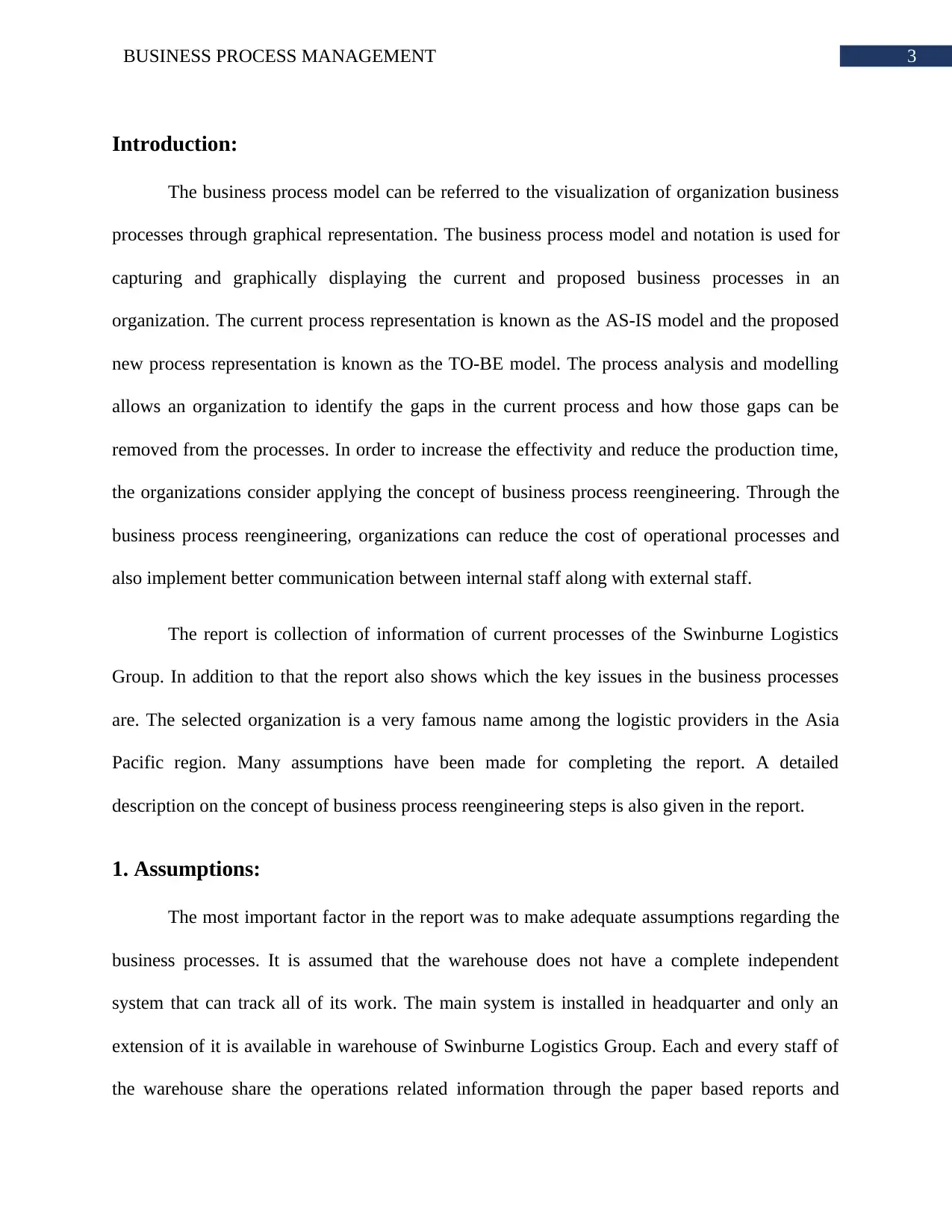
3BUSINESS PROCESS MANAGEMENT
Introduction:
The business process model can be referred to the visualization of organization business
processes through graphical representation. The business process model and notation is used for
capturing and graphically displaying the current and proposed business processes in an
organization. The current process representation is known as the AS-IS model and the proposed
new process representation is known as the TO-BE model. The process analysis and modelling
allows an organization to identify the gaps in the current process and how those gaps can be
removed from the processes. In order to increase the effectivity and reduce the production time,
the organizations consider applying the concept of business process reengineering. Through the
business process reengineering, organizations can reduce the cost of operational processes and
also implement better communication between internal staff along with external staff.
The report is collection of information of current processes of the Swinburne Logistics
Group. In addition to that the report also shows which the key issues in the business processes
are. The selected organization is a very famous name among the logistic providers in the Asia
Pacific region. Many assumptions have been made for completing the report. A detailed
description on the concept of business process reengineering steps is also given in the report.
1. Assumptions:
The most important factor in the report was to make adequate assumptions regarding the
business processes. It is assumed that the warehouse does not have a complete independent
system that can track all of its work. The main system is installed in headquarter and only an
extension of it is available in warehouse of Swinburne Logistics Group. Each and every staff of
the warehouse share the operations related information through the paper based reports and
Introduction:
The business process model can be referred to the visualization of organization business
processes through graphical representation. The business process model and notation is used for
capturing and graphically displaying the current and proposed business processes in an
organization. The current process representation is known as the AS-IS model and the proposed
new process representation is known as the TO-BE model. The process analysis and modelling
allows an organization to identify the gaps in the current process and how those gaps can be
removed from the processes. In order to increase the effectivity and reduce the production time,
the organizations consider applying the concept of business process reengineering. Through the
business process reengineering, organizations can reduce the cost of operational processes and
also implement better communication between internal staff along with external staff.
The report is collection of information of current processes of the Swinburne Logistics
Group. In addition to that the report also shows which the key issues in the business processes
are. The selected organization is a very famous name among the logistic providers in the Asia
Pacific region. Many assumptions have been made for completing the report. A detailed
description on the concept of business process reengineering steps is also given in the report.
1. Assumptions:
The most important factor in the report was to make adequate assumptions regarding the
business processes. It is assumed that the warehouse does not have a complete independent
system that can track all of its work. The main system is installed in headquarter and only an
extension of it is available in warehouse of Swinburne Logistics Group. Each and every staff of
the warehouse share the operations related information through the paper based reports and
Paraphrase This Document
Need a fresh take? Get an instant paraphrase of this document with our AI Paraphraser
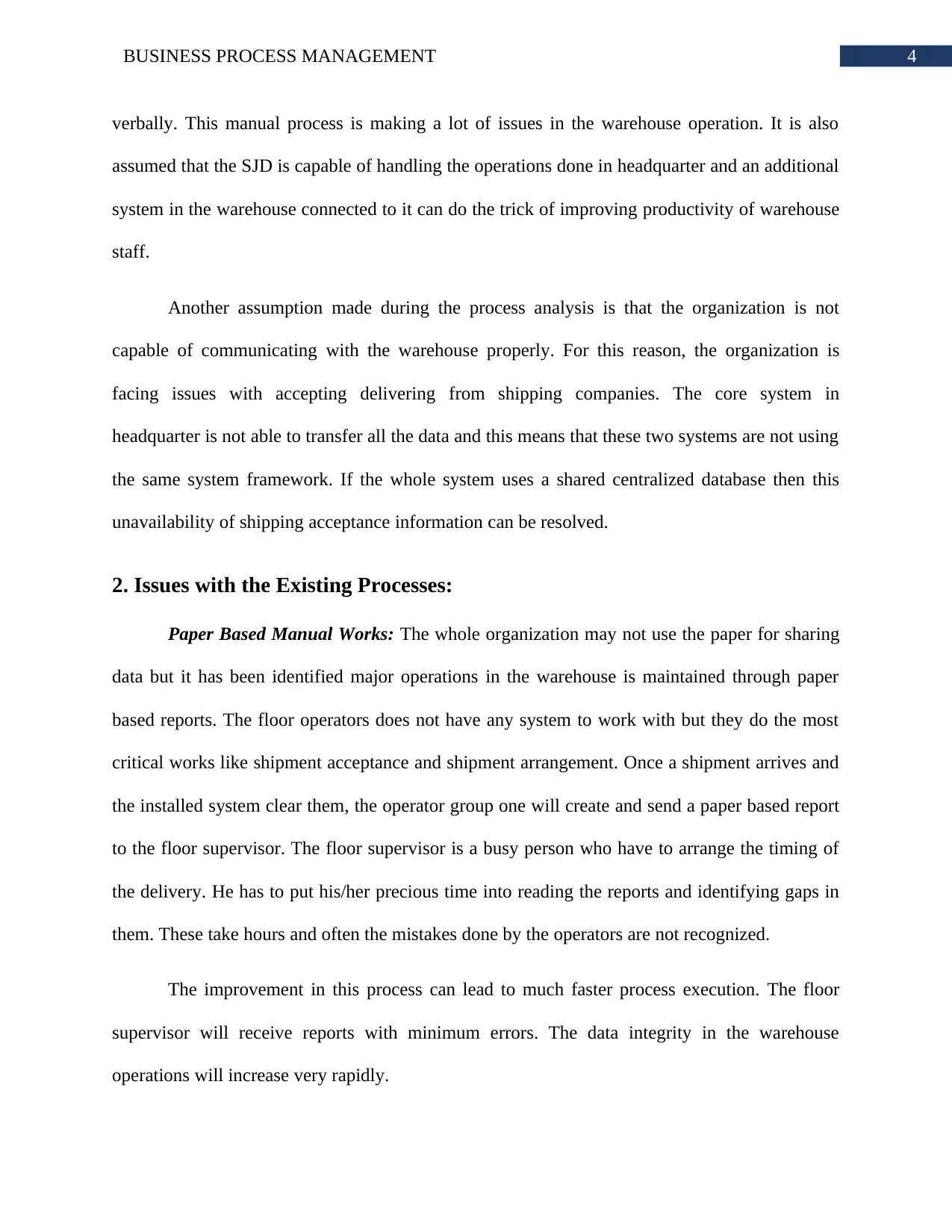
4BUSINESS PROCESS MANAGEMENT
verbally. This manual process is making a lot of issues in the warehouse operation. It is also
assumed that the SJD is capable of handling the operations done in headquarter and an additional
system in the warehouse connected to it can do the trick of improving productivity of warehouse
staff.
Another assumption made during the process analysis is that the organization is not
capable of communicating with the warehouse properly. For this reason, the organization is
facing issues with accepting delivering from shipping companies. The core system in
headquarter is not able to transfer all the data and this means that these two systems are not using
the same system framework. If the whole system uses a shared centralized database then this
unavailability of shipping acceptance information can be resolved.
2. Issues with the Existing Processes:
Paper Based Manual Works: The whole organization may not use the paper for sharing
data but it has been identified major operations in the warehouse is maintained through paper
based reports. The floor operators does not have any system to work with but they do the most
critical works like shipment acceptance and shipment arrangement. Once a shipment arrives and
the installed system clear them, the operator group one will create and send a paper based report
to the floor supervisor. The floor supervisor is a busy person who have to arrange the timing of
the delivery. He has to put his/her precious time into reading the reports and identifying gaps in
them. These take hours and often the mistakes done by the operators are not recognized.
The improvement in this process can lead to much faster process execution. The floor
supervisor will receive reports with minimum errors. The data integrity in the warehouse
operations will increase very rapidly.
verbally. This manual process is making a lot of issues in the warehouse operation. It is also
assumed that the SJD is capable of handling the operations done in headquarter and an additional
system in the warehouse connected to it can do the trick of improving productivity of warehouse
staff.
Another assumption made during the process analysis is that the organization is not
capable of communicating with the warehouse properly. For this reason, the organization is
facing issues with accepting delivering from shipping companies. The core system in
headquarter is not able to transfer all the data and this means that these two systems are not using
the same system framework. If the whole system uses a shared centralized database then this
unavailability of shipping acceptance information can be resolved.
2. Issues with the Existing Processes:
Paper Based Manual Works: The whole organization may not use the paper for sharing
data but it has been identified major operations in the warehouse is maintained through paper
based reports. The floor operators does not have any system to work with but they do the most
critical works like shipment acceptance and shipment arrangement. Once a shipment arrives and
the installed system clear them, the operator group one will create and send a paper based report
to the floor supervisor. The floor supervisor is a busy person who have to arrange the timing of
the delivery. He has to put his/her precious time into reading the reports and identifying gaps in
them. These take hours and often the mistakes done by the operators are not recognized.
The improvement in this process can lead to much faster process execution. The floor
supervisor will receive reports with minimum errors. The data integrity in the warehouse
operations will increase very rapidly.
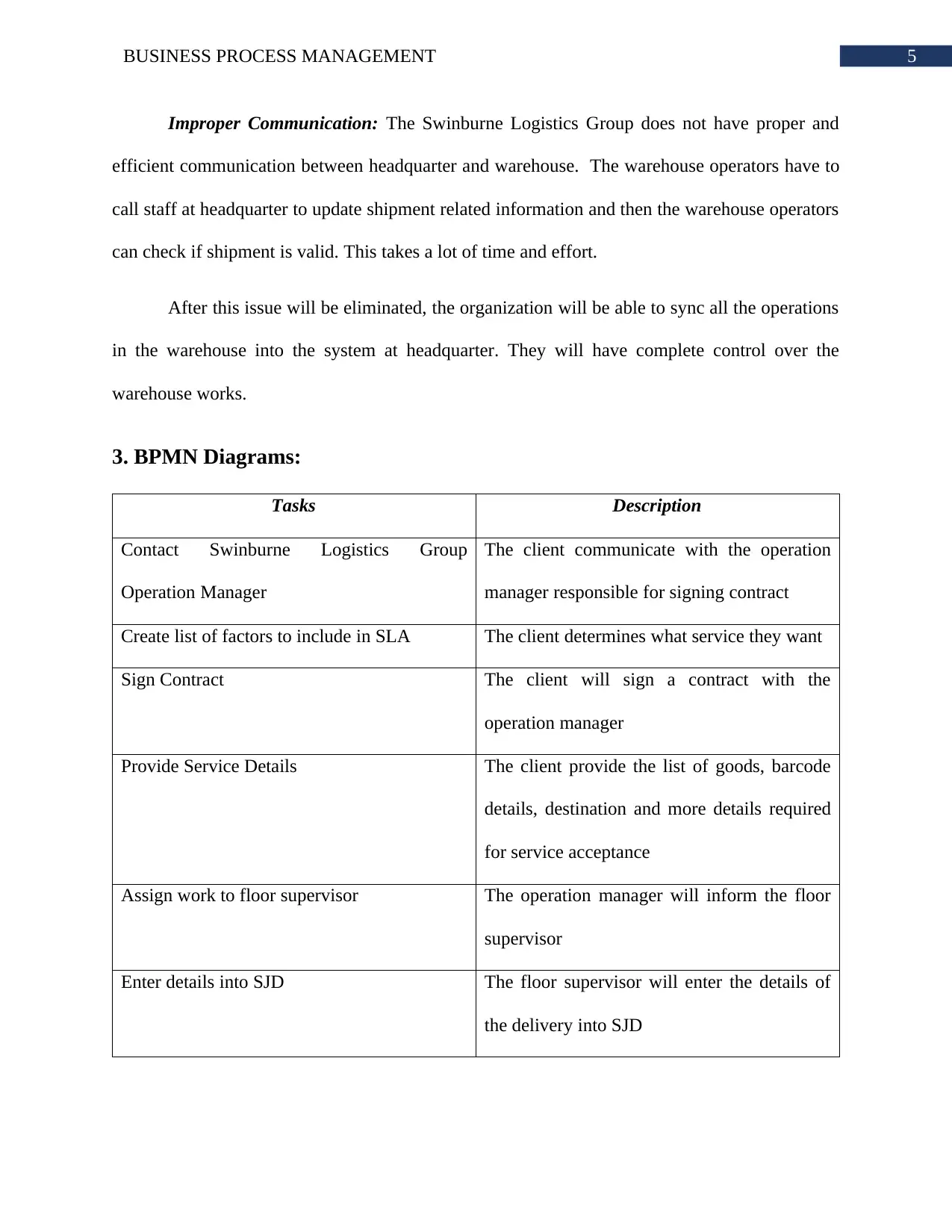
5BUSINESS PROCESS MANAGEMENT
Improper Communication: The Swinburne Logistics Group does not have proper and
efficient communication between headquarter and warehouse. The warehouse operators have to
call staff at headquarter to update shipment related information and then the warehouse operators
can check if shipment is valid. This takes a lot of time and effort.
After this issue will be eliminated, the organization will be able to sync all the operations
in the warehouse into the system at headquarter. They will have complete control over the
warehouse works.
3. BPMN Diagrams:
Tasks Description
Contact Swinburne Logistics Group
Operation Manager
The client communicate with the operation
manager responsible for signing contract
Create list of factors to include in SLA The client determines what service they want
Sign Contract The client will sign a contract with the
operation manager
Provide Service Details The client provide the list of goods, barcode
details, destination and more details required
for service acceptance
Assign work to floor supervisor The operation manager will inform the floor
supervisor
Enter details into SJD The floor supervisor will enter the details of
the delivery into SJD
Improper Communication: The Swinburne Logistics Group does not have proper and
efficient communication between headquarter and warehouse. The warehouse operators have to
call staff at headquarter to update shipment related information and then the warehouse operators
can check if shipment is valid. This takes a lot of time and effort.
After this issue will be eliminated, the organization will be able to sync all the operations
in the warehouse into the system at headquarter. They will have complete control over the
warehouse works.
3. BPMN Diagrams:
Tasks Description
Contact Swinburne Logistics Group
Operation Manager
The client communicate with the operation
manager responsible for signing contract
Create list of factors to include in SLA The client determines what service they want
Sign Contract The client will sign a contract with the
operation manager
Provide Service Details The client provide the list of goods, barcode
details, destination and more details required
for service acceptance
Assign work to floor supervisor The operation manager will inform the floor
supervisor
Enter details into SJD The floor supervisor will enter the details of
the delivery into SJD
⊘ This is a preview!⊘
Do you want full access?
Subscribe today to unlock all pages.

Trusted by 1+ million students worldwide

6BUSINESS PROCESS MANAGEMENT
Categorize Job The floor supervisor will arrange jobs as per
the requirements
Check Free Time The floor supervisor checks the free time slot
available for scheduling
Schedule Delivery Time The floor supervisor will schedule the
delivery
Provide Service Details The client provide the list of goods, barcode
details, destination and more details required
for service acceptance
Assign work to floor supervisor The operation manager will inform the floor
supervisor
Enter details into SJD The floor supervisor will enter the details of
the delivery into SJD
Save Job In case the potential job quantity is low then
floor supervisor saves the jobs
Inform Operator Otherwise the floor supervisor informs the
operator
Check Delivery Jobs The floor supervisor after receiving the
information check available delivery jobs
Re-arrange the ground spaces for the new
delivery jobs
The operator then re-arrange the jobs to
resolve the issue
Categorize Job The floor supervisor will arrange jobs as per
the requirements
Check Free Time The floor supervisor checks the free time slot
available for scheduling
Schedule Delivery Time The floor supervisor will schedule the
delivery
Provide Service Details The client provide the list of goods, barcode
details, destination and more details required
for service acceptance
Assign work to floor supervisor The operation manager will inform the floor
supervisor
Enter details into SJD The floor supervisor will enter the details of
the delivery into SJD
Save Job In case the potential job quantity is low then
floor supervisor saves the jobs
Inform Operator Otherwise the floor supervisor informs the
operator
Check Delivery Jobs The floor supervisor after receiving the
information check available delivery jobs
Re-arrange the ground spaces for the new
delivery jobs
The operator then re-arrange the jobs to
resolve the issue
Paraphrase This Document
Need a fresh take? Get an instant paraphrase of this document with our AI Paraphraser
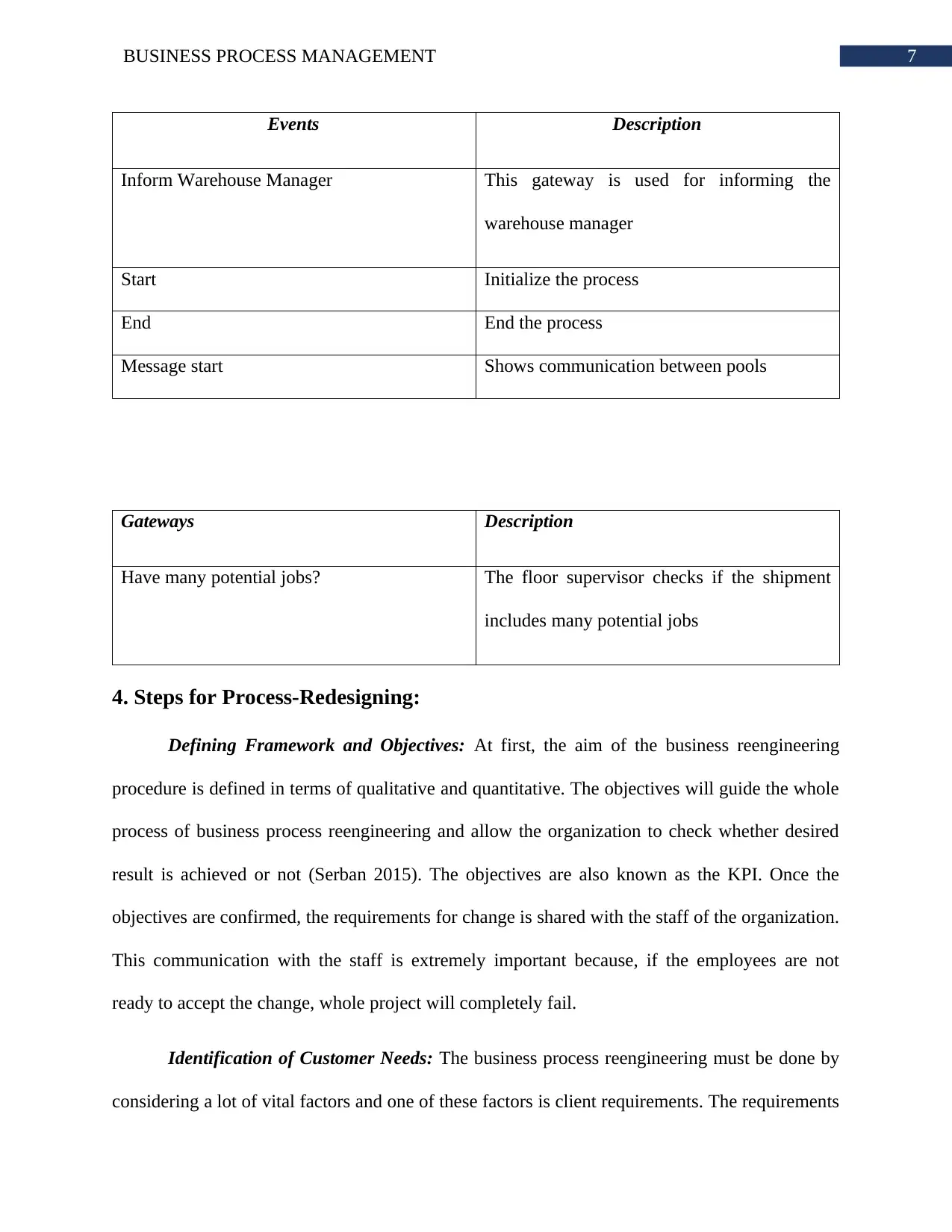
7BUSINESS PROCESS MANAGEMENT
Events Description
Inform Warehouse Manager This gateway is used for informing the
warehouse manager
Start Initialize the process
End End the process
Message start Shows communication between pools
Gateways Description
Have many potential jobs? The floor supervisor checks if the shipment
includes many potential jobs
4. Steps for Process-Redesigning:
Defining Framework and Objectives: At first, the aim of the business reengineering
procedure is defined in terms of qualitative and quantitative. The objectives will guide the whole
process of business process reengineering and allow the organization to check whether desired
result is achieved or not (Serban 2015). The objectives are also known as the KPI. Once the
objectives are confirmed, the requirements for change is shared with the staff of the organization.
This communication with the staff is extremely important because, if the employees are not
ready to accept the change, whole project will completely fail.
Identification of Customer Needs: The business process reengineering must be done by
considering a lot of vital factors and one of these factors is client requirements. The requirements
Events Description
Inform Warehouse Manager This gateway is used for informing the
warehouse manager
Start Initialize the process
End End the process
Message start Shows communication between pools
Gateways Description
Have many potential jobs? The floor supervisor checks if the shipment
includes many potential jobs
4. Steps for Process-Redesigning:
Defining Framework and Objectives: At first, the aim of the business reengineering
procedure is defined in terms of qualitative and quantitative. The objectives will guide the whole
process of business process reengineering and allow the organization to check whether desired
result is achieved or not (Serban 2015). The objectives are also known as the KPI. Once the
objectives are confirmed, the requirements for change is shared with the staff of the organization.
This communication with the staff is extremely important because, if the employees are not
ready to accept the change, whole project will completely fail.
Identification of Customer Needs: The business process reengineering must be done by
considering a lot of vital factors and one of these factors is client requirements. The requirements
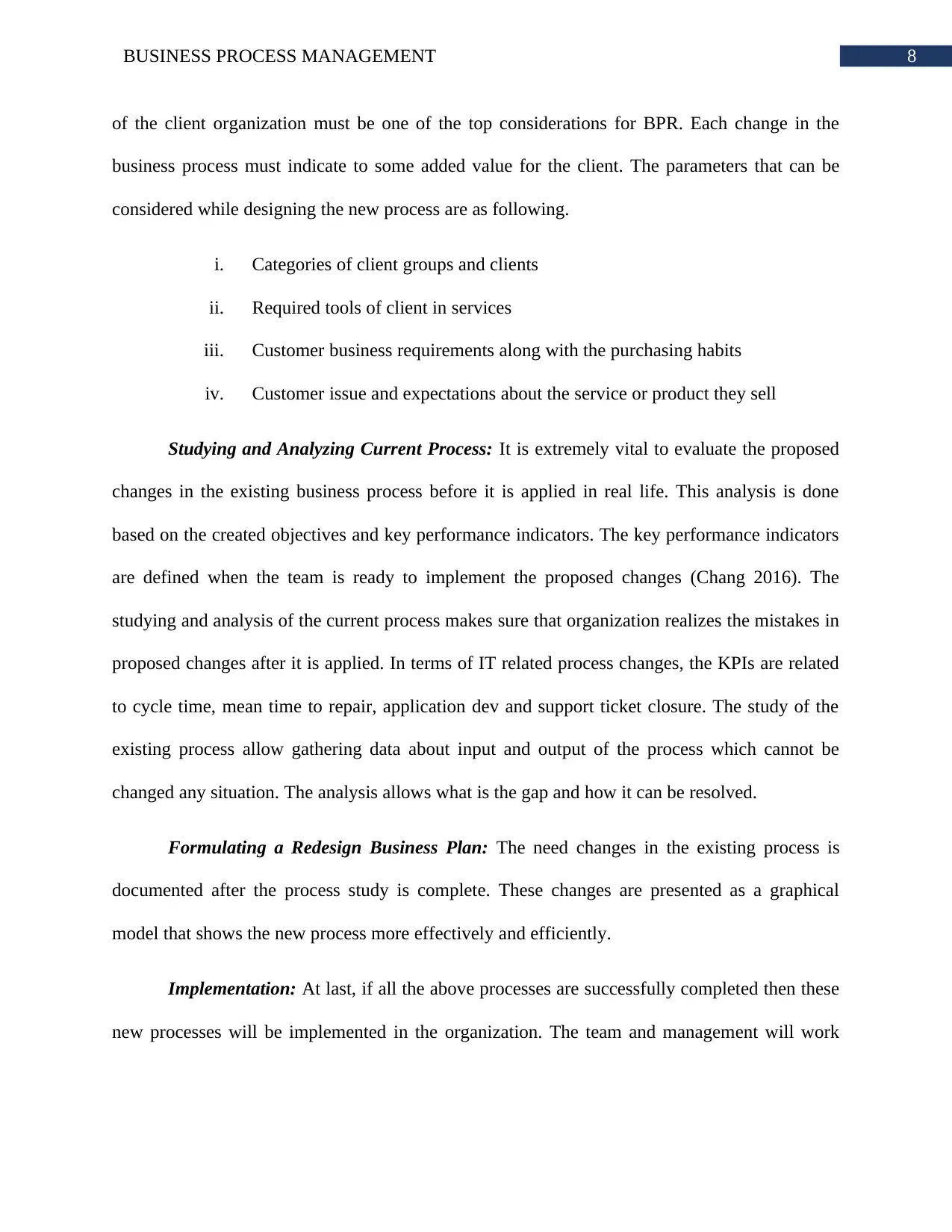
8BUSINESS PROCESS MANAGEMENT
of the client organization must be one of the top considerations for BPR. Each change in the
business process must indicate to some added value for the client. The parameters that can be
considered while designing the new process are as following.
i. Categories of client groups and clients
ii. Required tools of client in services
iii. Customer business requirements along with the purchasing habits
iv. Customer issue and expectations about the service or product they sell
Studying and Analyzing Current Process: It is extremely vital to evaluate the proposed
changes in the existing business process before it is applied in real life. This analysis is done
based on the created objectives and key performance indicators. The key performance indicators
are defined when the team is ready to implement the proposed changes (Chang 2016). The
studying and analysis of the current process makes sure that organization realizes the mistakes in
proposed changes after it is applied. In terms of IT related process changes, the KPIs are related
to cycle time, mean time to repair, application dev and support ticket closure. The study of the
existing process allow gathering data about input and output of the process which cannot be
changed any situation. The analysis allows what is the gap and how it can be resolved.
Formulating a Redesign Business Plan: The need changes in the existing process is
documented after the process study is complete. These changes are presented as a graphical
model that shows the new process more effectively and efficiently.
Implementation: At last, if all the above processes are successfully completed then these
new processes will be implemented in the organization. The team and management will work
of the client organization must be one of the top considerations for BPR. Each change in the
business process must indicate to some added value for the client. The parameters that can be
considered while designing the new process are as following.
i. Categories of client groups and clients
ii. Required tools of client in services
iii. Customer business requirements along with the purchasing habits
iv. Customer issue and expectations about the service or product they sell
Studying and Analyzing Current Process: It is extremely vital to evaluate the proposed
changes in the existing business process before it is applied in real life. This analysis is done
based on the created objectives and key performance indicators. The key performance indicators
are defined when the team is ready to implement the proposed changes (Chang 2016). The
studying and analysis of the current process makes sure that organization realizes the mistakes in
proposed changes after it is applied. In terms of IT related process changes, the KPIs are related
to cycle time, mean time to repair, application dev and support ticket closure. The study of the
existing process allow gathering data about input and output of the process which cannot be
changed any situation. The analysis allows what is the gap and how it can be resolved.
Formulating a Redesign Business Plan: The need changes in the existing process is
documented after the process study is complete. These changes are presented as a graphical
model that shows the new process more effectively and efficiently.
Implementation: At last, if all the above processes are successfully completed then these
new processes will be implemented in the organization. The team and management will work
⊘ This is a preview!⊘
Do you want full access?
Subscribe today to unlock all pages.

Trusted by 1+ million students worldwide
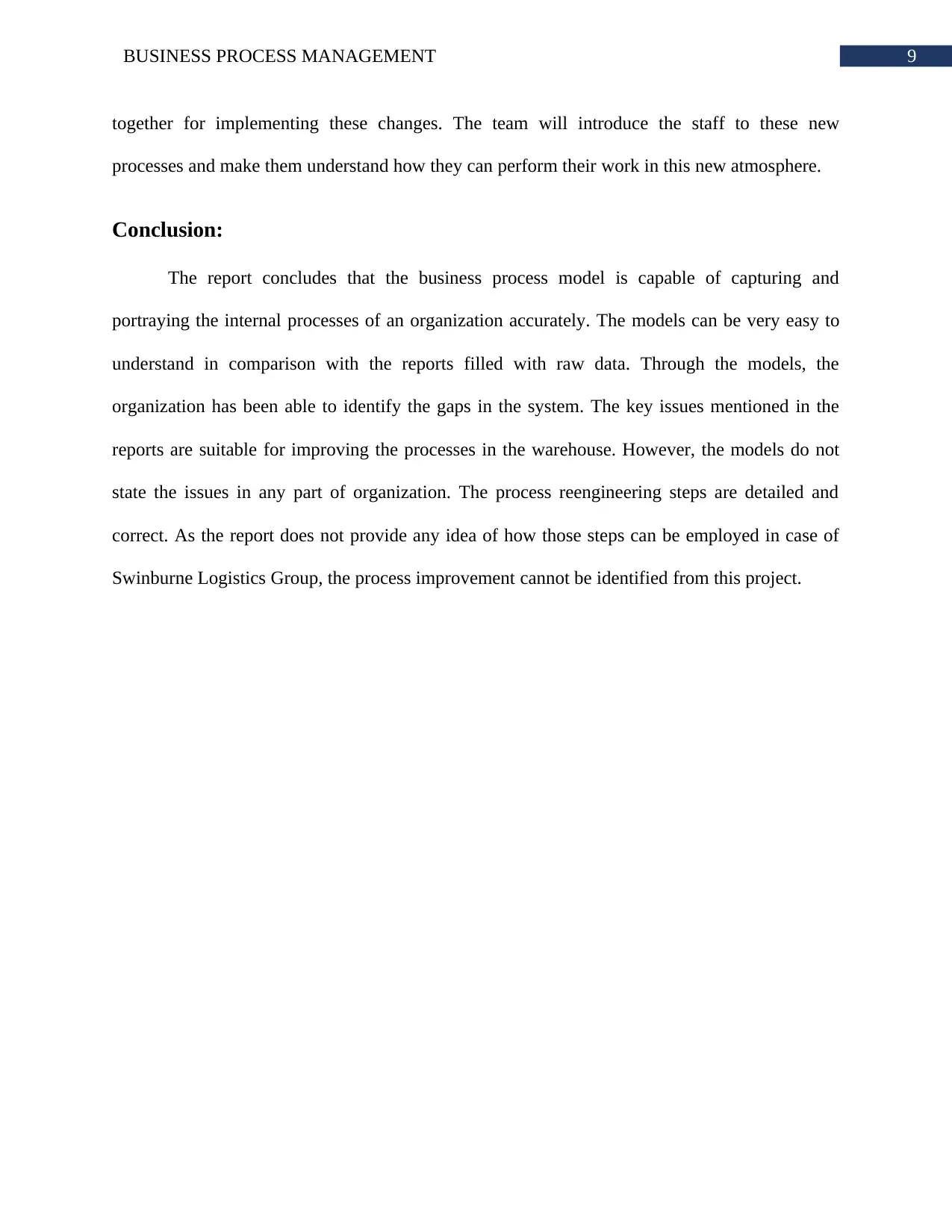
9BUSINESS PROCESS MANAGEMENT
together for implementing these changes. The team will introduce the staff to these new
processes and make them understand how they can perform their work in this new atmosphere.
Conclusion:
The report concludes that the business process model is capable of capturing and
portraying the internal processes of an organization accurately. The models can be very easy to
understand in comparison with the reports filled with raw data. Through the models, the
organization has been able to identify the gaps in the system. The key issues mentioned in the
reports are suitable for improving the processes in the warehouse. However, the models do not
state the issues in any part of organization. The process reengineering steps are detailed and
correct. As the report does not provide any idea of how those steps can be employed in case of
Swinburne Logistics Group, the process improvement cannot be identified from this project.
together for implementing these changes. The team will introduce the staff to these new
processes and make them understand how they can perform their work in this new atmosphere.
Conclusion:
The report concludes that the business process model is capable of capturing and
portraying the internal processes of an organization accurately. The models can be very easy to
understand in comparison with the reports filled with raw data. Through the models, the
organization has been able to identify the gaps in the system. The key issues mentioned in the
reports are suitable for improving the processes in the warehouse. However, the models do not
state the issues in any part of organization. The process reengineering steps are detailed and
correct. As the report does not provide any idea of how those steps can be employed in case of
Swinburne Logistics Group, the process improvement cannot be identified from this project.
Paraphrase This Document
Need a fresh take? Get an instant paraphrase of this document with our AI Paraphraser
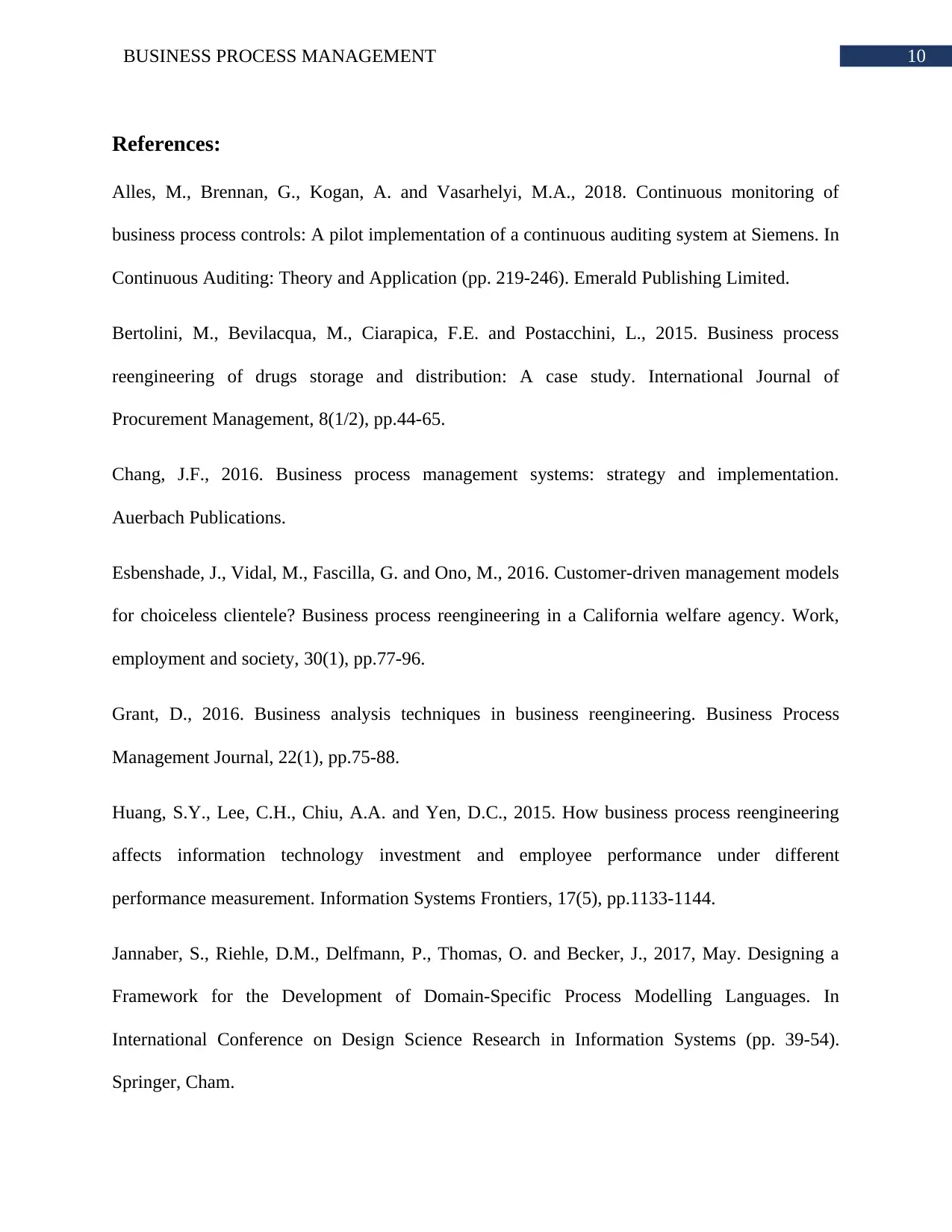
10BUSINESS PROCESS MANAGEMENT
References:
Alles, M., Brennan, G., Kogan, A. and Vasarhelyi, M.A., 2018. Continuous monitoring of
business process controls: A pilot implementation of a continuous auditing system at Siemens. In
Continuous Auditing: Theory and Application (pp. 219-246). Emerald Publishing Limited.
Bertolini, M., Bevilacqua, M., Ciarapica, F.E. and Postacchini, L., 2015. Business process
reengineering of drugs storage and distribution: A case study. International Journal of
Procurement Management, 8(1/2), pp.44-65.
Chang, J.F., 2016. Business process management systems: strategy and implementation.
Auerbach Publications.
Esbenshade, J., Vidal, M., Fascilla, G. and Ono, M., 2016. Customer-driven management models
for choiceless clientele? Business process reengineering in a California welfare agency. Work,
employment and society, 30(1), pp.77-96.
Grant, D., 2016. Business analysis techniques in business reengineering. Business Process
Management Journal, 22(1), pp.75-88.
Huang, S.Y., Lee, C.H., Chiu, A.A. and Yen, D.C., 2015. How business process reengineering
affects information technology investment and employee performance under different
performance measurement. Information Systems Frontiers, 17(5), pp.1133-1144.
Jannaber, S., Riehle, D.M., Delfmann, P., Thomas, O. and Becker, J., 2017, May. Designing a
Framework for the Development of Domain-Specific Process Modelling Languages. In
International Conference on Design Science Research in Information Systems (pp. 39-54).
Springer, Cham.
References:
Alles, M., Brennan, G., Kogan, A. and Vasarhelyi, M.A., 2018. Continuous monitoring of
business process controls: A pilot implementation of a continuous auditing system at Siemens. In
Continuous Auditing: Theory and Application (pp. 219-246). Emerald Publishing Limited.
Bertolini, M., Bevilacqua, M., Ciarapica, F.E. and Postacchini, L., 2015. Business process
reengineering of drugs storage and distribution: A case study. International Journal of
Procurement Management, 8(1/2), pp.44-65.
Chang, J.F., 2016. Business process management systems: strategy and implementation.
Auerbach Publications.
Esbenshade, J., Vidal, M., Fascilla, G. and Ono, M., 2016. Customer-driven management models
for choiceless clientele? Business process reengineering in a California welfare agency. Work,
employment and society, 30(1), pp.77-96.
Grant, D., 2016. Business analysis techniques in business reengineering. Business Process
Management Journal, 22(1), pp.75-88.
Huang, S.Y., Lee, C.H., Chiu, A.A. and Yen, D.C., 2015. How business process reengineering
affects information technology investment and employee performance under different
performance measurement. Information Systems Frontiers, 17(5), pp.1133-1144.
Jannaber, S., Riehle, D.M., Delfmann, P., Thomas, O. and Becker, J., 2017, May. Designing a
Framework for the Development of Domain-Specific Process Modelling Languages. In
International Conference on Design Science Research in Information Systems (pp. 39-54).
Springer, Cham.

11BUSINESS PROCESS MANAGEMENT
Milani, F., Dumas, M., Ahmed, N. and Matulevičius, R., 2016. Modelling families of business
process variants: a decomposition driven method. Information Systems, 56, pp.55-72.
Reijers, H.A., Mendling, J. and Recker, J., 2015. Business process quality management. In
Handbook on Business Process Management 1 (pp. 167-185). Springer, Berlin, Heidelberg.
Serban, A.I., 2015. Managing Transformation: Business Process Reengineering or Total Quality
Management. International Journal of Academic Research in Business and Social Sciences, 5(5),
pp.81-86.
Sinz, E., 2018. A Short Comparison of Business Process Modelling Methods under the
Perspective of Structure and Behaviour. Enterprise Modelling and Information Systems
Architectures, 13, pp.63-68.
Milani, F., Dumas, M., Ahmed, N. and Matulevičius, R., 2016. Modelling families of business
process variants: a decomposition driven method. Information Systems, 56, pp.55-72.
Reijers, H.A., Mendling, J. and Recker, J., 2015. Business process quality management. In
Handbook on Business Process Management 1 (pp. 167-185). Springer, Berlin, Heidelberg.
Serban, A.I., 2015. Managing Transformation: Business Process Reengineering or Total Quality
Management. International Journal of Academic Research in Business and Social Sciences, 5(5),
pp.81-86.
Sinz, E., 2018. A Short Comparison of Business Process Modelling Methods under the
Perspective of Structure and Behaviour. Enterprise Modelling and Information Systems
Architectures, 13, pp.63-68.
⊘ This is a preview!⊘
Do you want full access?
Subscribe today to unlock all pages.

Trusted by 1+ million students worldwide
1 out of 15
Related Documents
Your All-in-One AI-Powered Toolkit for Academic Success.
+13062052269
info@desklib.com
Available 24*7 on WhatsApp / Email
![[object Object]](/_next/static/media/star-bottom.7253800d.svg)
Unlock your academic potential
Copyright © 2020–2025 A2Z Services. All Rights Reserved. Developed and managed by ZUCOL.





